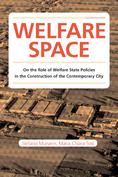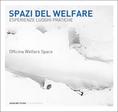European policies social housing urbanism agriculture architecture cartography local plans infrastructures public policies fabrication public art design mega-events paesaggio urbanization Environment Community conferences progetto urbano innovation ecological networks events special news city-regions representation
Welfare Space
On the Role of Welfare State Policies in the Construction of the Contemporary City
Stefano Munarin, Maria Chiara Tosi
Commenting on the European Union’s reception of the Nobel Peace Prize in 2012, Jurgen Habermas pointed out how, along with the merit of having achieved peace after repeated fratricidal wars and of having developed the constitutive strength of democracy, the Swedish Committee wanted to reward the third great feat of Europe: its social model based on the welfare state.
This book deals with the relationship between (more or less national) welfare policies and cities, the ways in which the complex set of actions designed to ensure greater well-being to different populations will help to build the city, depositing there facilities and spaces and, conversely, how the city and its various spatial articulations contribute (or fail to contribute) to the well-being of its inhabitants. The reflections offered here are the result of research carried out in recent years, mainly through continuous experimentation with the city: through the analysis of its spaces, the development of projects and the deconstruction of its policies. Research that took the Italian city and the Veneto region in particular as a case study, and which developed also through the exploration of a number of European cities (Berlin, Stockholm, Bordeaux, Hamburg, Copenhagen, London, Paris, Edinburgh, Glasgow, Amsterdam, Porto), and a literature that necessarily passes through several fields of knowledge.
The book consists of two parts. In the first we attempt to define the concept of “welfare space”, discussing the current value of the concept and its use within a new urban planning strategy. In the second instead, considering the central area of Veneto (comprising Venice, Padua, Treviso and the areas between) as a laboratory and assuming the exploratory nature of the project (De Carlo 1989, Viganò 2010), we analyze the spatial results of the welfare policies that have been enacted here and at the same time, we develop some projects that, starting from the welfare spaces, try to re-imagine the contemporary city in greater totality.
CONTENTS
Foreword | 5
Introduction | 7
Welfare State/Welfare Space | 15
Concepts and questions
• The Fatigue of Living
• Welfare and Right to the City
• Urbanism Interrogated by Welfare
• Welfare and Relational Practices
Welfare Space/Urban Space | 49
Towards New Life Cycles for the Veneto Region?
• Equipping the Territory: a School, a Kindergarten, a Sport Field for Each Bell-towers
• Seasons, Players and Forms of Social Welfare
• Emerging Phenomena
• Scenarios
• Veneto Equipped and Accessible
• Planning Explorations
Why Spaces? | 114
References | 117
ABOUT THE RESEARCH:
The book is the outcome of a study on the relationship between welfare and city, carried out over the past few years. Little by little, the reflections that have arisen as a result of the research have been published in various texts:
- S. Munarin, M. C. Tosi, “Lo spazio del Welfare in Europa”, Urbanistica, 139, 2009; - S. Munarin, M. C. Tosi, “The Space of Welfare in Europe”, in J. Rosenmann et al. (ed.), The New Urban Question, Papiroz, Rijswijk 2010;
- S. Munarin, M.C. Tosi with M. Pace and C. Renzoni, Spazi del welfare. Esperienze, luoghi pratiche, Quodlibet, Macerata 2011. Some parts of this last book in particular have been taken up and reworded here.
- S. Munarin, V. Martelliano (Eds.), Spazi, storie e soggetti del welfare, Gangemi, Roma, 2012.
Coordinated by Stefano Munarin and Maria Chiara Tosi, the research has seen the participation of Ruben Baiocco, Cristina Renzoni (research fellows), Michela Pace (collaborator), Brando Posocco, Elena Gomiero, Laura Bogon, Paola Silvestrini, Alessandro Danese, Maddalena Orsato, Cecilia Luca, Giorgia Ferlin, Sara Peruzzo, Silvia Orso, Serena Marchetto, Federica Nalesso, Giulia Paccagnella, Elisabetta Zamperin (university students who participated in a degree laboratory).
ABOUT THE AUTHORS:
Stefano Munarin (1964) and Maria Chiara Tosi (1965), urban planners, Associate Professors of the IUAV University of Venice, have also taught at the Universities of Catania and Trento, participated in various university research projects (Itaten, The transformation of the urban habitat in Europe; Returb, I futuri della cityà; INFRA, Recycle Italy) and worked on various city plans (Brescia, Pesaro; Macerata, Ferrara, Feltre, Belluno, Venice).
Their research and work is mainly focused on the processes of transformation of the territory, the issues raised by hydraulic equilibrium, and the relationship between welfare policies and construction of the city.
Related articles:




Planum
The Journal of Urbanism
ISSN 1723-0993
owned by
Istituto Nazionale di Urbanistica
published by
Planum Association
ISSN 1723-0993 | Registered at Court of Rome 4/12/2001, num. 514/2001
Web site realized by ChannelWeb & Planum Association | Powered by BEdita 3














